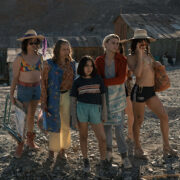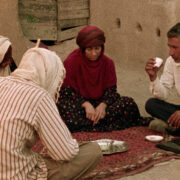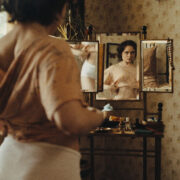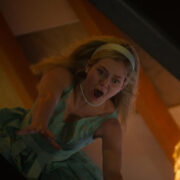FROM UP ON POPPY HILL: Gorō Miyazaki’s Best Film, 10 Years Later
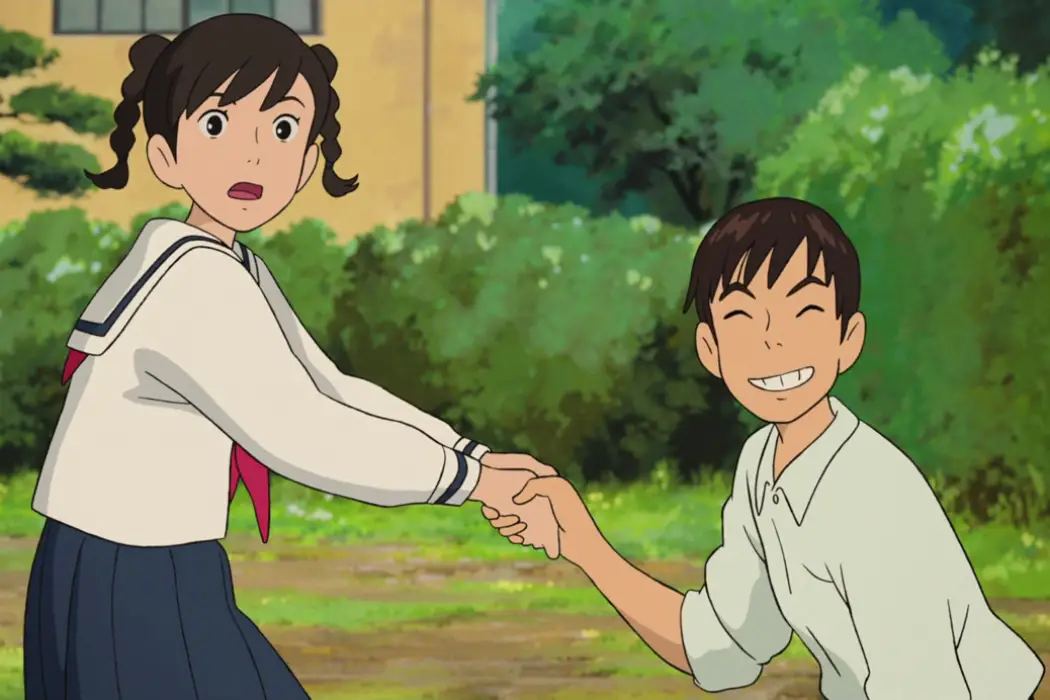
Film critic, Ithaca College and University of St Andrews graduate,…
Few Studio Ghibli films are set in the real world. Few of them engage with real-world politics, and even fewer (only two) feature incest as a major plot point. That’s From Up on Poppy Hill for you, a real odd duck within the Ghibli canon. Written by Hayao Miyazaki and directed by his son, Gorō, From Up on Poppy Hill represents a glacier-speed step for the prolific animation house — the first generation of Ghibli filmmakers handing the reins to a younger one. This year, the film celebrates its 10th anniversary.
From Up on Poppy Hill follows Umi (Masami Nagasawa), a young schoolgirl who runs her family’s lodging house, where she lives with her grandmother and siblings while their mother is away in America. Umi’s father died in the Korean War, and she raises flags every day from Poppy Hill as a memorial. At school, she meets Shun (Junichi Okada), an enigmatic young sailor who runs the school paper and sweeps Umi up in a fight to save the students’ clubhouse from demolition. As they develop feelings for each other, secrets float to the surface, and they each have to confront their families’ past.
The project was a proving ground for Gorō as a filmmaker — he had previously helmed Ghibli’s Tales from Earthsea, which, though a huge success financially, is today widely considered one of the studio’s worst films. Before Earthsea, Gorō had no experience with animation. He worked as a landscape architect and interior designer, designing the Ghibli Museum before being hand-picked for Earthsea by Ghibli producer Toshio Suzuki.
Whereas the hard fantasy of Earthsea departed from the studio’s style, Poppy Hill shares more DNA with past Ghibli films, like Only Yesterday, Whisper of the Heart, and Kiki’s Delivery Service. Ten years after its initial release, From Up on Poppy Hill remains Gorō’s best film, albeit an inferior effort from the legendary studio. Where most Ghibli films are revelatory and inventive, even transcendent, Poppy Hill is merely adequate, and even its best scenes feel like pale imitations of the studio’s far more realized works.
Save The Latin Quarter
From Up on Poppy Hill is a straightforward, realistic feature for Ghibli, with no sprites or spirits in sight. Besides a few dreamy interludes, the Miyazaki father-son duo keeps the story grounded. Like Isao Takahata’s masterpiece Only Yesterday or Yoshifumi Kondō’s soulful Whisper of the Heart, Gorō’s film is mostly concerned with first love, heartbreak, tradition, and family.
Umi and Shun have a great meet-cute. At a demonstration to save his beloved clubhouse, Shun dives off a roof, trampolines off a bush, and lands in a pool. It’s very Frank Capra. Umi thinks he’s an oaf, but she visits the clubhouse for herself — dubbed the “Latin Quarter,” it’s a massive Swiss Family Robinson–style library full of shouting, hormonal schoolboys, from the long-winded Philosophy Club to the two-man Archaeology Club on the top floor, which shares an office with Shun and his printing press.
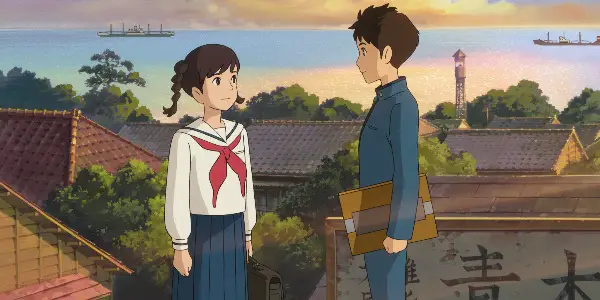
In the Latin Quarter and Umi’s boarding house on Poppy Hill, Gorō’s history as an interior designer fully pays off. These are the film’s two key locations, each realized with such fine attention to detail that you can practically smell the clubhouse’s dusty old-book aromas or feel the cool morning breeze at the boarding house when Umi goes out to raise her flags. Every interior shot in the Latin Quarter is a work of art, and you get the sense that Gorō’s trying to capture what Hayao’s messy workrooms and desks must have looked like. Even locations we only see once, like the twilight streets of Tokyo or the grandmother’s room, which opens up into a lovely garden with an ocean view, boast vibrant greens and reds and have genuine depth to their compositions.
Several silent, contemplative scenes in the film, like a tugboat sailing through early-morning fog or a bike ride down Poppy Hill in the rain, are certainly standouts, though they feel like remixes of scenes from better Ghibli productions. The bike sequence in Kiki’s Delivery Service, for example, is better than anything in Poppy Hill. And as far as the film’s lovely treatment of landscape, it never quite tops the lush countryside of My Neighbor Totoro or the solemn, vibrant realism of Whisper of the Heart.
Gorō also tends to be fiercely literal in his use of imagery. A character has a voiceover about how his wife started nursing a baby, and we see the baby being nursed. Umi talks about how her father’s ship exploded, and we see a ship blow up in spectacular fashion. Leaves nothing to the imagination. If Hayao approaches his scripts like an animator, finding clever visual ways of representing the written word, then Gorō approaches them like a foreman — where do the bricks go, how high are the walls, how do we get the final product to match the blueprint?
Still, Gorō has some trademarks as a storyteller that shine in From Up on Poppy Hill and which crop up in his other two films, Tales from Earthsea and 2020’s CG feature Earwig and the Witch. Gorō uses more closeups in his work, for example, and loves animating light in novel ways — this film’s dream sequence and Earthsea have these sumptuous shots that backlight their characters with almost-angelic radiance.
He loves his subversive paternal authority figures, too — the “save the clubhouse” plot climaxes with Shun, Umi, and Shun’s right-hand man, Shirō (Shunsuke Kazama) going from Yokohama to Tokyo to visit the school board’s chairman (Teruyuki Kagawa). The film builds up the chairman as this imposing, hard-to-reach titan, but he winds up being a softie.
Gorō’s soundtracks for Poppy Hill and Earwig and the Witch are both fundamentally different from every other Ghibli score, too. They’re heavily jazz-inflected, with Earwig veering even more into punk and rock. Poppy Hill has an occasional piano score, mostly for the dream sequences, that is absolutely magical when it crops up. The jazz, on the other hand, deflates most of the scenes it’s in, and it always makes the action on-screen feel weirdly inconsequential, like we’re watching a commercial for a film rather than the film itself. (The one time it works, however, is for the big sequence where the kids clean out the clubhouse, nearly identical to a cleaning montage in Earwig.)
The film also stands out for its overt political themes. Hayao normally avoids direct political themes in his films, but Poppy Hill is set in 1963 amid a wave of student activism and organizing, and his clubhouse plot pays homage to that. But Poppy Hill is not one of Hayao’s better scripts, and so the clubhouse discussion is never convincingly tied to any sociopolitical force within Japan. The students want to save it because of culture, we’re told, but what culture specifically and from where is never addressed. I’m not expecting Hayao to have written La Chinoise here, but there were actual student-led riots in Japan during this decade, and to instead focus the story on this milquetoast baby’s-first-political-demonstration stuff feels like a waste of time. The clubhouse only ever represents a vague notion of Japan’s past.
The Earthquake
Perhaps the abundant nostalgia worked in the film’s favor, though. Just four months before the film’s release on July 16, 2011, tragedy struck Japan. The country experienced its most severe earthquake on record, resulting in a tsunami and the Fukushima Daiichi nuclear disaster. In total, nearly 20,000 people died, hundreds of thousands were displaced from their homes, and millions more were without electricity.
The rolling blackouts throughout the country made production difficult, and animators had to work through the night to make their deadline. Only a small number of staff at Ghibli were directly affected by the earthquake, which was hundreds of miles away from the Tokyo offices and did not cause any deaths in the city, but they all were mentally affected. At the time of the quake, the animation was only halfway completed.
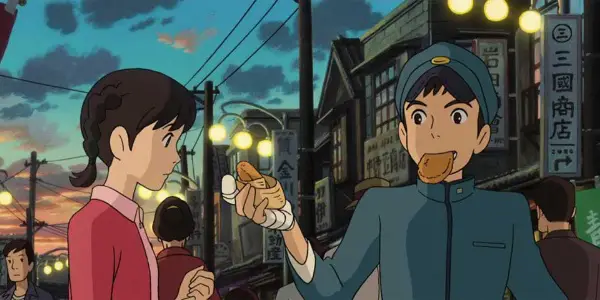
Both the Japan of the film and the Japan of 2011 were marred by national trauma, eager to move on. Posters for the 1964 Tokyo Olympics litter From Up on Poppy Hill — this is, after all, the event that’ll show the world that Japan has fully rebounded after World War II. This theme makes Poppy Hill worth revisiting now, especially, as Tokyo has another Olympic Games on the way. This time, though, the country is reeling from COVID-19, as the virus continues to spread and the Olympics draw nearer.
The earthquake undoubtedly affected From Up on Poppy Hill’s box office returns — when the film debuted in 2011, it was a financial success, grossing over $62 million worldwide and ending up third overall at the year’s Japanese box office. But the film grossed far less than previous Ghibli titles and is one of few Ghibli films not distributed internationally by Disney — GKIDS released a dubbed version two years later in 2013. But what good business the film did generate is likely audiences wanting to escape, to seek refuge in a simpler time in their nation’s history with one of the coziest animation studios around.
Of course, none of this — the politics, the production, the earthquake — is the reason that From Up on Poppy Hill is notorious within the Ghibli canon. The real reason has to do with the, er, romance at the core of the film.
*sigh* The Incest
Here it is, the conversation we’ve all been dreading. So, the film is based on the shōjo manga From Coquelicot Hill, and I have no idea if the potentially incestuous relationship is in that version of the story or not. Spoilers for Poppy Hill — after 40 minutes spent building up the romance between Shun and Umi, Shun realizes that his father and Umi’s father are potentially one and the same. Umi’s devastated when she finds out. Finally, in Tokyo, while they’re waiting for a train, Umi pours her heart out to Shun, saying that she doesn’t care if they’re related, that she loves him anyway.
You can just imagine the Disney execs who must have seen an early cut of this, pulled out their hair by the fistfuls, and emphatically decided not to release this in America. Having seen the subbed and the dubbed versions, though, I think the dub — which, by the way, features absolutely incredible work from the late Anton Yelchin and Sarah Bolger as Shun and Umi — actually downplays the romantic beats in the film’s first half.
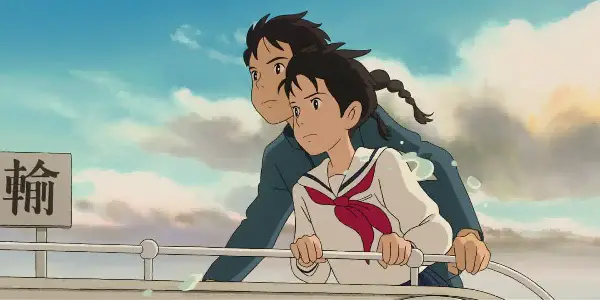
From that train sequence, though, it’s clear that the incest at the heart of the film is a love so strong that the film has to will it into being OK. We get not one but two scenes where characters reassure the two of them that, nope, it was all a mix-up, you’re not actually related after all.
So through a surplus of coincidence and a Richard Curtis–esque race against time in the finale, the universe of Poppy Hill successfully bends its narrative into allowing these two to bang. I have no idea how it played in Japan, but I find the resolution deeply uncomfortable, mostly because we didn’t need the incest angle at all and yet spent so much time soaking in that conflict, all while Umi and Shun’s schoolmates egged them on from the sidelines. I have no idea why Hayao wanted to tell this story.
Conclusion: Hayao And Son
All of Gorō’s films are, to some degree, about his troubled relationship with his dad. You see that in the complex range of father figures throughout Earthsea, Poppy Hill, and Earwig, as well as in how eager Gorō is to break Ghibli tradition and do something wild. Hayao was an absent father, and when Gorō began making films, Hayao was relentlessly critical, even cruel, toward his son’s work. From Up on Poppy Hill represents the only true professional partnership the filmmakers had, and all of that attention shines through in the finished product.
The animation here is more stylish and lively than Gorō’s other films, and the story, despite its worrisome romance and lame politics, successfully delivers some small-stakes rewards. There’s some amusing stuff here, for sure — those classic fat Ghibli teardrops are back, and they’re fatter and wetter than ever; the physics professor is playfully named “Old Man Suzuki” after the Ghibli producer, and it’s fun to see a Miyazaki film where the plot is basically a 90s skateboard movie.
For all the film’s problems, Studio Ghibli’s work always bears a warm familiarity. A ship captain tells Shun and Umi, “meeting you both is like seeing old friends again.” And that’s how watching From Up on Poppy Hill feels. Ten years on, it might not be one of the most well-regarded or well-produced of the studio’s films, but it’s a high point in Gorō’s career and one of the final brushstrokes in his father’s, and that’s more than enough to justify a visit to Poppy Hill.
What do you think of From Up on Poppy Hill? Where does it rank for you among Studio Ghibli’s library? Comment below and let us know.
Watch From Up on Poppy Hill
Does content like this matter to you?
Become a Member and support film journalism. Unlock access to all of Film Inquiry`s great articles. Join a community of like-minded readers who are passionate about cinema - get access to our private members Network, give back to independent filmmakers, and more.
Film critic, Ithaca College and University of St Andrews graduate, head of the "Paddington 2" fan club.









